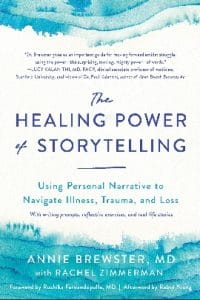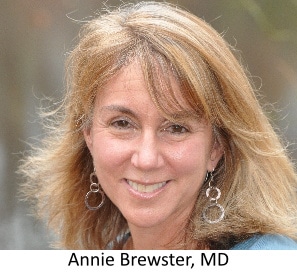Editor’s note: Annie Brewster, MD, founder of Health Story Collaborative, and a friend to the Society for Participatory Medicine, has just published “The Healing Power of Storytelling: Using Personal Narrative to Navigate Illness, Trauma, and Loss.” In this excerpt Dr. Brewster describes coming to terms with her diagnosis of multiple sclerosis (MS). “Authentic storytelling,” she writes, “connects us by reminding us that we are all human and that we are all flawed. What a relief to realize that we are not alone or unique in our imperfections!” 
Getting “Unstuck”
When I was first diagnosed with MS, a disease with no cure, I was terrified that if I acknowledged my disease, it would consume me, and that “Annie” would become synonymous with “sick person.” I didn’t want to get stuck in this role. As a doctor, I do occasionally see patients who appear stuck in this way; they lose themselves within their diagnoses or define themselves as patients above all else, with symptoms and medical appointments dictating the structure of their lives. This can happen even when the acuity of the medical situation does not demand such vigilance. My initial response, on the other hand, was to deny my illness completely, but this proved to be just another way to get stuck. Either extreme—living in complete denial or identifying solely as a sick person—makes healing nearly impossible.
Storytelling allowed me to broaden my view, to recognize that the label of MS need not dictate my life. Through telling my story and hearing from others navigating similar health issues, I began, eventually, to feel “unstuck.” It is an ongoing process, one that is inherently in motion. Yes, I have a chronic, degenerative medical condition. Now what? My story continues to unfold.
Promoting Self-Acceptance
As I have said, at first I tried hard to ignore my diagnosis, to deny its existence. Over time, however, the truth gnawed at me, even as I did my best to stuff it down. This is not me, I told myself when I encountered fictional characters with MS in books and movies, who were always significantly disabled by the disease—or so it seemed. As a medical resident, I occasionally ended up caring for a hospitalized patient with MS. I remember one in particular, a fifty-year-old woman with aggressive MS, bed-bound as a result, admitted for infected pressure sores on her backside that had led to sepsis, a bloodstream infection. I struggled every time I entered her room—dueling with myself in my mind. This is not me. This could be me. All I remember is the special blue air mattress she lay on, soft to relieve the pressure, undulating beneath her as the nurses turned her on her side to change her wound dressings. I don’t remember her face or her words. I don’t even remember the role that I played in her care. I saw only the pain and suffering I imagined she was experiencing and what I perceived to be her dependence on others. I was terrified.
For a while, I was stuck in this dichotomous, overly simplistic pattern of thought. It was all or nothing. Accepting MS felt like inviting pain, suffering, and disability into my life, so I rejected it. I saw no other way forward. Of course, that didn’t work for long. With time and more symptoms, I was forced to admit that I did, indeed, have MS. I realized that I had to change the story I was telling myself for the sake of my well-being. Suffering can coexist with joy, strength with disability, and my story can hold this complexity. MS is a part of me but not all of me. I gradually reframed the story—my story—and began sharing it with others. Ultimately, this is what helped me move away from fragmentation and self-rejection toward integration and self-love. It was like letting out a long-held breath.
Connecting with Others
I now realize that I failed to consider the whole person lying on that blue hospital air mattress all those years ago. The story I told myself about her was one-dimensional, centered on loss, and it was my own fear and lack of self-acceptance that kept me from seeing her fully. I wish I could go back and talk to her now. We cannot authentically see or be seen by others if we refuse to see ourselves, and this makes intimacy impossible. Self-acceptance is the first step, but we will remain alone unless we find the courage to share who we are with others.
Ultimately, storytelling is a relational act. In my experience, exposing our personal vulnerabilities, authentically and without apology, is scary, but also a huge relief. When such sharing occurs in the context of a supportive community, space opens up, barriers break down, and separation dissolves. Authentic storytelling connects us by reminding us that we are all human and that we are all flawed. What a relief to realize that we are not alone or unique in our imperfections! Mutual honesty, transparency, and story exchange can deepen existing relationships and inspire new ones. We can be who we are without pretense, and this allows others to be the same. As described in chapter 3, research tells us that social isolation can be toxic, associated with an earlier onset of cognitive and physical decline and with an increased risk of death. We are in the midst of a “loneliness epidemic” in our culture. Storytelling brings people together.
From The Healing Power of Storytelling: Using Personal Narrative to Navigate Illness, Trauma, and Loss by Annie Brewster with Rachel Zimmerman, published by North Atlantic Books, copyright © 2022. Reprinted by permission of publisher.
Did you enjoy this book excerpt? Sign the Manifesto and learn more about becoming a member.






Recent Comments